You’ll master jewelry design by understanding ten fundamental principles: balance (symmetrical, asymmetrical, or radial arrangements), contrast (using opposing colors and textures), unity (creating cohesion through repetition), emphasis (directing attention to focal points), proportion (sizing elements appropriately), pattern (structured repetition), rhythm (establishing visual flow), harmony (ensuring elements work together), scale (sizing for the wearer), and movement (guiding the eye through designs). These principles transform amateur pieces into professional craftsmanship that resonates emotionally with wearers and creates memorable, elegant jewelry.
Balance: Creating Visual Harmony in Your Designs
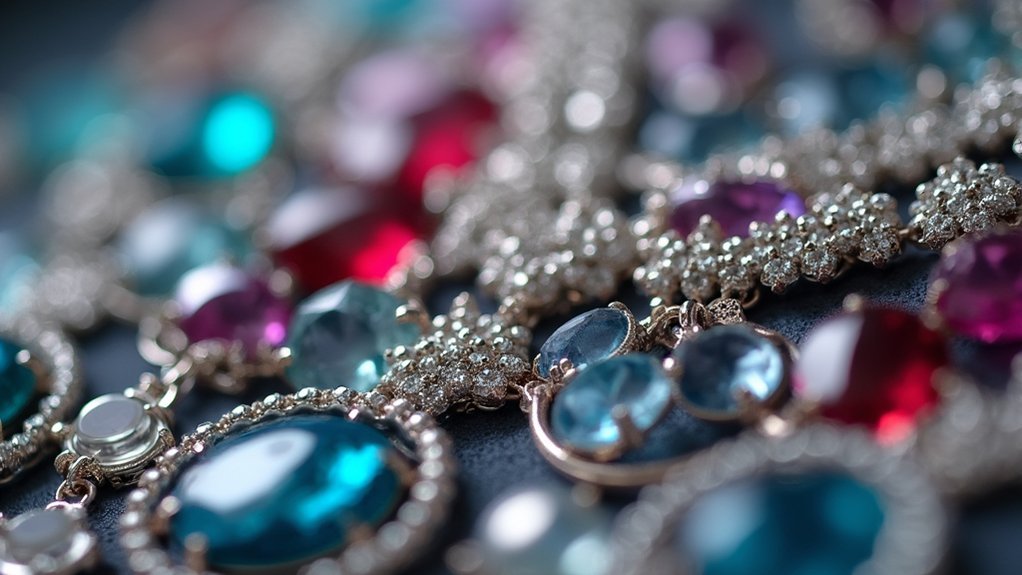
Picture a stunning necklace where every element feels perfectly placed—this exemplifies balance, the foundation of compelling jewelry design.
You’ll achieve this harmony through three approaches: symmetrical, asymmetrical, or radial arrangements.
Symmetrical balance creates mirror images across a central line, offering classic elegance. Asymmetrical balance uses varying sizes, textures, and colors to create equilibrium without identical repetition. Radial balance emanates from a center point, allowing dynamic designs with strategic off-balance elements for added visual interest.
Balance in jewelry design flows through three distinct paths—symmetrical elegance, asymmetrical harmony, and radial energy radiating from center points.
When placing gemstones and components, you’re guiding the viewer’s eye smoothly across your piece. This thoughtful distribution prevents any single element from overwhelming your design.
Proper balance enhances both wearability and aesthetic appeal, ensuring your jewelry feels harmonious rather than chaotic or lopsided.
Contrast: Using Opposing Elements for Visual Impact
You’ll create striking visual impact in your jewelry by mastering contrast through opposing elements that make pieces pop.
Start with color contrast techniques using complementary hues or dramatic light-dark combinations.
Then explore texture and material differences like pairing smooth metals with rough stones.
Don’t overlook size and scale variations, as mixing large statement elements with delicate details creates dynamic tension that draws the eye.
Color Contrast Techniques
When someone first encounters a piece of jewelry that truly captivates them, there’s often one powerful design principle at work: color contrast.
You’ll create stunning visual interest by pairing opposing colors from the color wheel—think deep sapphire blues against warm orange citrines or emerald greens alongside ruby reds.
Master these essential color contrast techniques:
- Light meets dark: Combine pale moonstone with black onyx to create dramatic depth and dimension.
- Texture amplification: Pair smooth, polished garnets with rough, matte-finished silver to enhance color vibrancy.
- Complementary schemes: Use purple amethyst with yellow gold settings to evoke powerful emotional responses.
You’ll discover that strategic color contrast doesn’t just attract attention—it guides the viewer’s eye exactly where you want it, transforming ordinary pieces into unforgettable wearable art.
Texture and Material Differences
The interplay between contrasting textures creates jewelry’s most compelling visual stories. You’ll achieve striking texture contrast by combining matte and polished finishes within a single piece. This technique generates visual interest that draws the eye and adds sophisticated depth to your designs.
Pair rough gemstones with smooth metals to establish clear focal points. The opposition between these surfaces naturally guides viewers’ attention where you want it.
Don’t overlook material combinations like leather and metal – these contrasts evoke emotional responses while creating dynamic aesthetics.
Experiment with weaving fabrics through metal chains to introduce tactile complexity. Your texture choices directly impact wearability and comfort, so consider how different surfaces feel against skin.
Smart texture contrast elevates basic designs into memorable pieces that engage both sight and touch.
Size and Scale Variations
Three fundamental scale relationships drive successful jewelry design: oversized statements paired with delicate accents, graduated size progressions, and unexpected miniature details against bold backdrops.
When you master size and scale variations, you’ll create compelling visual interest that guides viewers’ eyes exactly where you want them.
Large gemstones naturally become focal points, while smaller supporting elements provide balance without competing for attention. You can evoke specific emotions through scale relationships—tiny charms suggest intimacy and delicacy, while bold components convey confidence and drama.
Consider wearability alongside aesthetics. Oversized pieces might overwhelm, while microscopic details can disappear if poorly positioned.
- A chunky chain necklace crowned with a whisper-thin pendant charm
- Massive statement earrings dotted with tiny seed pearl clusters
- Bold geometric rings accented with delicate filigree details
Unity: Bringing All Design Elements Together
Harmony serves as the cornerstone of exceptional jewelry design, transforming individual components into a cohesive masterpiece that captivates both wearer and observer.
You’ll achieve unity by ensuring all elements—color, shape, and texture—work together seamlessly rather than competing for attention. This creates compelling visual interest without overwhelming chaos.
Repeat specific colors, textures, and shapes throughout your design to build cohesion. You’ll find that proportional relationships among components enhance this unity; using similarly sized stones creates balance and prevents visual discord.
Strategic repetition of design motifs ties varied elements together, ensuring they’re perceived as part of a unified narrative.
When you master unity, your jewelry resonates emotionally with wearers, creating memorable pieces that feel like singular entities rather than collections of random parts.
Emphasis: Directing Attention to Focal Points
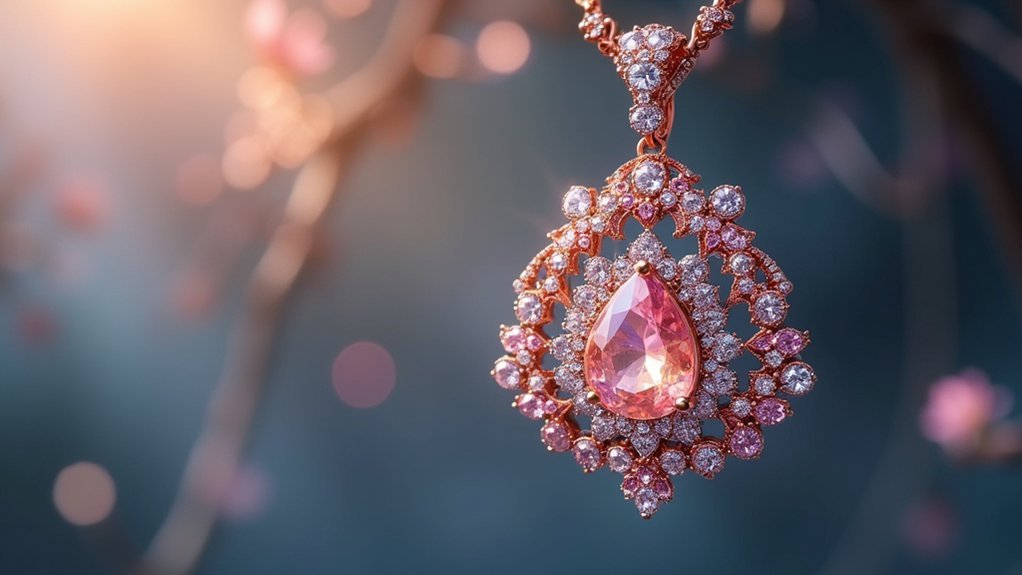
While unity creates cohesion across your entire piece, emphasis strategically directs the viewer’s eye to specific focal points that define your jewelry’s character.
You’ll create powerful emphasis through contrasting elements—think brilliant diamonds against matte metal or smooth pearls beside textured surfaces. Size becomes your strongest tool; larger components naturally command attention, so scale your centerpiece accordingly.
Position matters tremendously. Place your focal points at the center or top of your design for maximum impact.
Don’t overlook asymmetrical compositions—they’ll guide the viewer’s eye through strategic visual weight distribution.
- A radiant emerald nestled among delicate silver filigree work
- Hammered gold textures surrounding a smooth, polished cabochon
- Graduated pearl sizes leading to one magnificent central stone
Proportion: Achieving Proper Size Relationships
Getting proportions right separates elegant jewelry from amateur attempts—it’s the difference between a piece that feels perfectly balanced and one that seems awkward or unwearable. You’ll create visual interest when components complement each other through proper scale relationships.
| Element | Too Large | Too Small | Just Right |
|---|---|---|---|
| Center Stone | Overwhelms setting | Gets lost in design | Commands attention naturally |
| Accent Stones | Compete with focal point | Barely visible | Support main gemstone |
| Setting | Bulky, uncomfortable | Fragile, inadequate | Secure, proportional |
| Chain/Band | Dominates pendant | Can’t support weight | Balances overall piece |
Central gemstones appear more proportional when surrounded by supportive accent stones that create cohesive looks. Use consistent ratios and trust your instincts—proper proportion enhances visual appeal while ensuring your jewelry remains comfortable and wearable.
Movement: Guiding the Eye Through Your Design
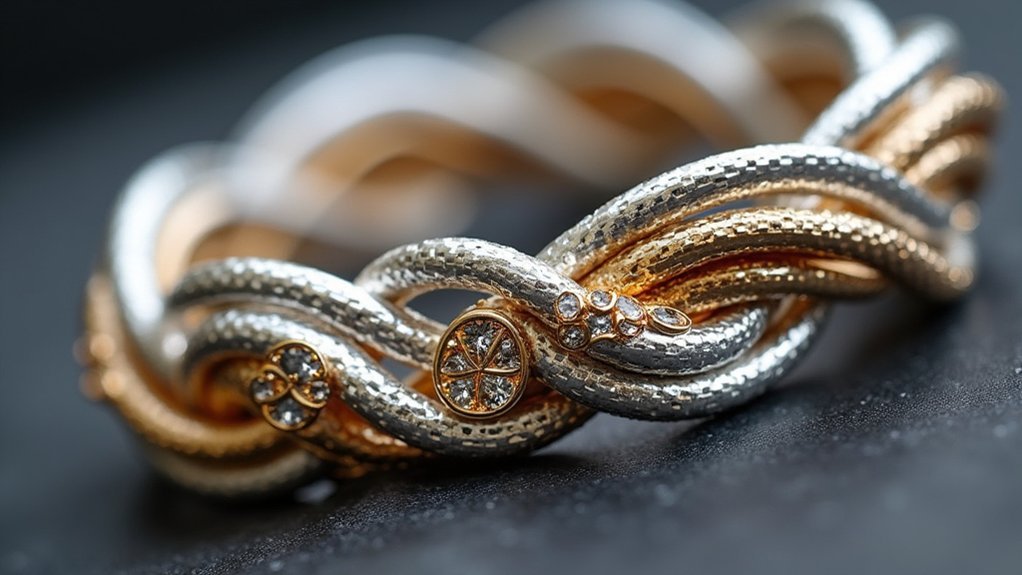
You’ll create enchanting jewelry by mastering movement—the art of guiding your viewer’s eye through deliberate visual flow paths that connect each element of your design.
Strategic arrangements of dynamic shapes, varying sizes, and intentional orientations transform static pieces into engaging compositions that feel alive and energetic.
Color placement becomes your secret weapon for directing attention, as contrasting hues and textures create rhythmic pathways that pull the eye exactly where you want it to go.
Creating Visual Flow Paths
How does a master jeweler transform a collection of stones and metals into an enchanting piece that draws your eye exactly where it’s meant to go?
They create deliberate visual flow paths that guide your gaze through strategic movement. You’ll achieve this by positioning elements that naturally lead from one focal point to another, establishing rhythm and visual interest throughout your design.
Consider these flow-creating techniques:
- Cascading gemstones that descend like a waterfall, pulling your eye downward through graduated sizes
- Curved metal lines that sweep gracefully around the piece, creating serpentine pathways for visual exploration
- Repeating motifs positioned at intervals that create stepping stones for your gaze to follow
You’re fundamentally choreographing how someone experiences your jewelry, transforming static materials into dynamic storytelling that captivates and engages.
Dynamic Shape Arrangements
Building on these flow principles, dynamic shape arrangements become your most powerful tool for creating movement that captivates viewers from first glance.
You’ll create compelling visual interest by strategically positioning geometric and organic shapes to guide the eye naturally through your design. Start with a focal point, then arrange supporting elements in curves or diagonal lines that lead viewers on a deliberate journey around your piece.
Contrast circular elements with angular ones to establish rhythm and prevent monotony. Vary sizes progressively – large to small or vice versa – to create depth and directional flow.
Repeated motifs establish visual echoes that reinforce movement patterns. Remember, you’re orchestrating how someone experiences your jewelry, controlling their gaze through intentional shape placement that tells your design’s story effectively.
Color-Driven Eye Movement
Three strategic color applications transform static jewelry into dynamic visual journeys that command attention and direct viewer focus with precision.
You’ll create powerful movement by understanding how color naturally guides the eye through your design composition.
Warm colors like reds and golds pull attention toward focal points, while cool blues and greens create peaceful shifts between elements.
You can establish visual pathways by strategically placing contrasting colors that create stopping points for the viewer’s gaze, then using complementary tones to bridge connections between different design areas.
- A cascade of deep sapphires flowing into lighter aquamarines creates downward movement like water
- Alternating warm amber and cool jade stones produces rhythmic visual pulses across a bracelet
- Gradient color shifts from dark garnets to bright citrines generate smooth directional flow
Pattern: Creating Structure Through Repetition
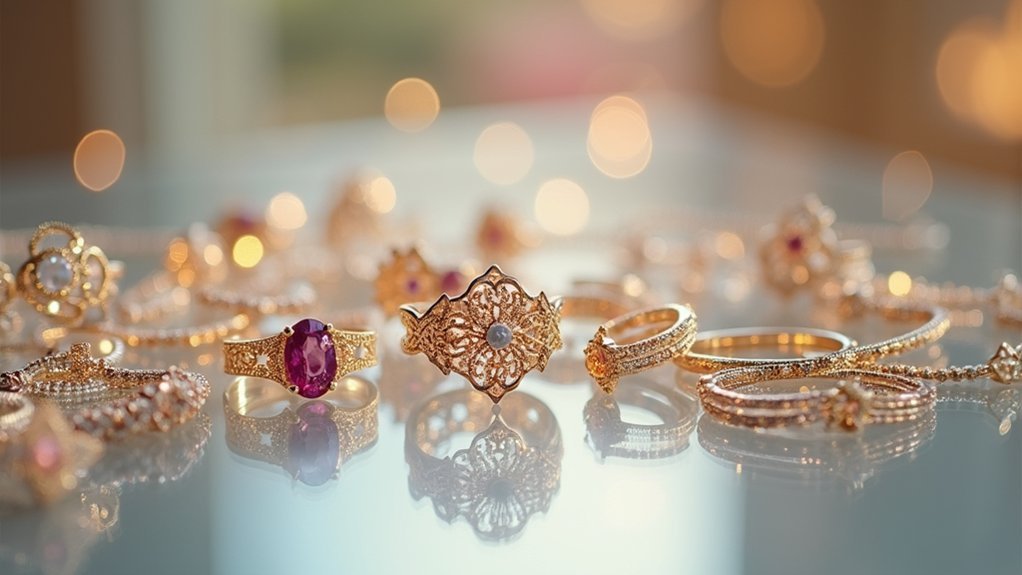
Pattern forms the backbone of compelling jewelry design, transforming simple elements into sophisticated compositions through strategic repetition. You’ll discover that utilizing simple patterns can enhance complexity while intricate ones create unique identity for your pieces.
| Pattern Type | Example | Visual Effect | Skill Level | Application |
|---|---|---|---|---|
| Regular Repeat | Uniform bead sequence | Structured rhythm | Beginner | Necklaces, bracelets |
| Graduated Scale | Increasing stone sizes | Dynamic movement | Intermediate | Pendants, earrings |
| Alternating Elements | Metal-stone-metal | Visual interest | Beginner | All jewelry types |
| Organic Flow | Nature-inspired curves | Fluid movement | Advanced | Statement pieces |
| Geometric Grid | Square/triangle repeats | Modern structure | Intermediate | Contemporary designs |
Pattern guides viewers’ eyes through your design, creating purposeful journeys. Early practice with repetition improves your understanding of balance and proportion—essential skills for visually compelling jewelry.
Rhythm: Establishing Flow and Continuity
You’ll create rhythm in your jewelry by establishing visual flow patterns that guide the viewer’s eye smoothly across your piece.
Strategic placement of repetitive elements with thoughtful spacing generates this rhythmic quality, whether you’re alternating bead sizes or varying gemstone colors.
This deliberate movement transforms static designs into dynamic pieces that tell a story through their carefully orchestrated visual journey.
Creating Visual Flow Patterns
How can you transform a static piece of jewelry into one that dances with visual energy? You’ll create compelling visual flow patterns by strategically repeating elements throughout your design.
When you establish rhythm through consistent shapes, colors, or textures, you’re guiding the viewer’s eye on an intentional journey around your piece.
Consider these powerful techniques to enhance visual interest:
- Graduated beading – Start with large pearls at the center, gradually decreasing to tiny ones at the clasp
- Alternating metal finishes – Weave polished and brushed silver links to create rhythmic contrast
- Progressive color shifts – Blend sapphire blue through aquamarine to crystal clear stones
Your rhythm becomes the heartbeat of the design, ensuring every angle reveals fresh discoveries while maintaining cohesive harmony throughout the piece.
Repetitive Elements and Spacing
When you master the art of repetition and spacing, you’ll discover that rhythm emerges naturally from the careful placement of similar elements throughout your jewelry piece.
You’ll create visual interest by repeating shapes, colors, or textures at consistent intervals, allowing the viewer’s eye to follow a predictable yet engaging path.
Consider spacing as your tool for controlling tempo. Tight spacing creates urgency and intensity, while generous spacing offers breathing room and elegance.
You can alternate element sizes or gradually shift colors to build dynamic patterns that captivate attention.
Balance repetition with variation to avoid monotony. Change one aspect—perhaps size or orientation—while keeping others consistent.
This technique maintains continuity while adding excitement, ensuring your design feels intentional and sophisticated rather than predictable.
Dynamic Movement Through Design
As your eye travels across a well-designed piece of jewelry, it follows an invisible current that pulls it from one element to the next—this is rhythm in action.
You create this dynamic movement by strategically repeating shapes, colors, or textures that guide the viewer’s gaze smoothly throughout your design.
Gradual shifts in size or color intensity enhance this rhythmic flow, while alternating textures add both visual interest and tactile appeal.
When you master rhythm, you’re not just arranging elements—you’re choreographing an experience that energizes your piece and creates emotional resonance.
- Cascading pearls that gradually decrease in size, creating downward visual momentum
- Alternating polished and hammered metal segments that create textural waves
- Gemstones changing from deep sapphire to pale blue, forming color rivers
Harmony: Ensuring All Elements Work in Concert
Harmony acts as the invisible thread that weaves together every element of your jewelry design into a unified masterpiece.
You’ll create visual interest by repeating colors, textures, and shapes throughout your piece, preventing your design from appearing random or chaotic. Focus on establishing proportional relationships between components – guarantee no single element dominates the others.
You’ll maintain harmony by selecting a consistent style or theme that runs through your entire design. Whether you’re working with geometric patterns or organic forms, stick to your chosen aesthetic.
When you balance color palettes, match textures thoughtfully, and guarantee shapes complement each other, you’ll achieve that coveted sense of elegance. This harmony makes your jewelry more appealing and creates lasting visual impact.
Scale: Understanding Size in Relation to the Wearer
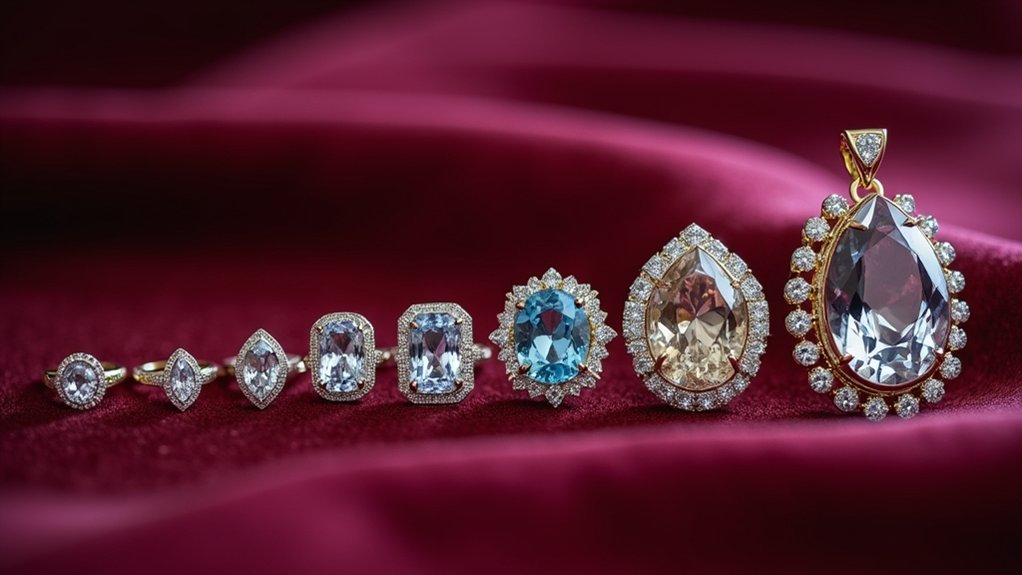
Scale determines whether your harmonious design feels perfectly balanced on its intended wearer or awkwardly out of place.
You’ll need to evaluate the relationship between your jewelry’s size and the wearer’s body proportions. A delicate chain might disappear on someone with a broad chest, while chunky statement earrings could overwhelm petite features.
Understanding proportion helps you create visually pleasing designs that enhance rather than distract. Reflect on these scale relationships:
- A large gemstone paired with substantial metalwork to maintain visual weight
- Ring designs sized appropriately for the wearer’s hand proportions
- Pendant length chosen to complement the wearer’s neck and torso
You’ll achieve the best results when you balance oversized elements with smaller counterparts, creating natural visual flow throughout your design.
Frequently Asked Questions
What Are the 5 Main Functions of Jewellery?
You’ll find jewelry serves five main functions: expressing your personal style, displaying status and wealth, commemorating life events, representing cultural or religious beliefs, and providing practical uses like timekeeping or clothing fasteners.
How Do I Start Jewellery Designing?
Start sketching your ideas in a dedicated notebook, then experiment with inexpensive materials like beads and wire. Take online workshops to learn techniques, create prototypes to test designs, and study basic design principles.
What Do I Need to Get Started Making Jewelry?
You’ll need basic tools like pliers and wire cutters, plus materials such as beads, wire, and findings. Don’t forget a bead board, sketchbook for designs, and safety equipment like goggles and gloves.
Do Jewelry Designers Make Good Money?
You can make good money as a jewelry designer, especially if you’re freelancing or have established your brand. Entry-level positions start around $30,000, but experienced designers often earn $75,000 or more annually.
In Summary
You’ve now got nine essential jewelry design principles to transform your creations from amateur to professional. Don’t try mastering them all at once—pick one principle and practice it until it becomes second nature. Remember, these aren’t rigid rules but flexible guidelines that’ll help you develop your unique style. Start with simple projects, experiment boldly, and trust your instincts. Your jewelry-making journey’s just beginning, and you’re already equipped with professional knowledge.

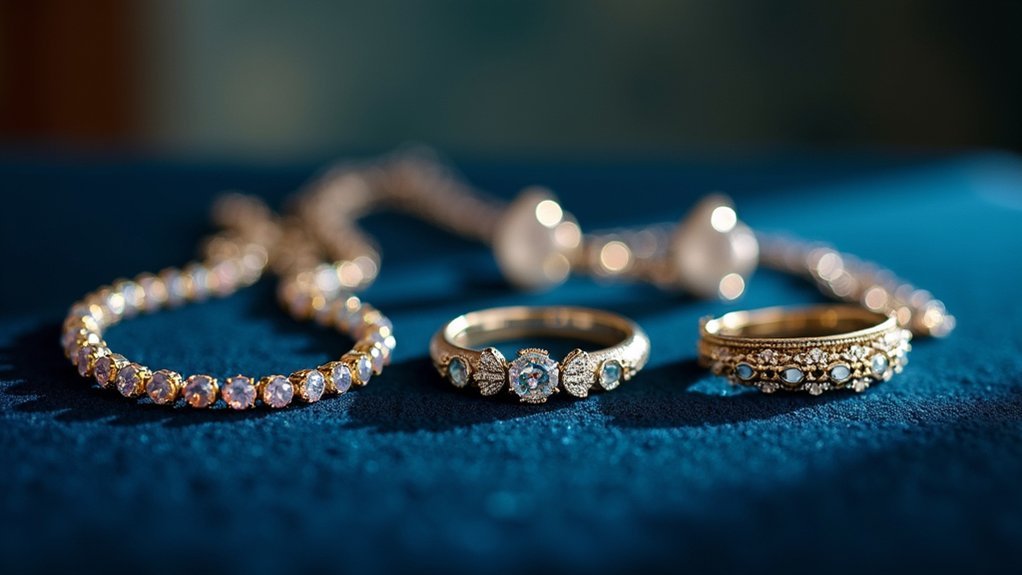
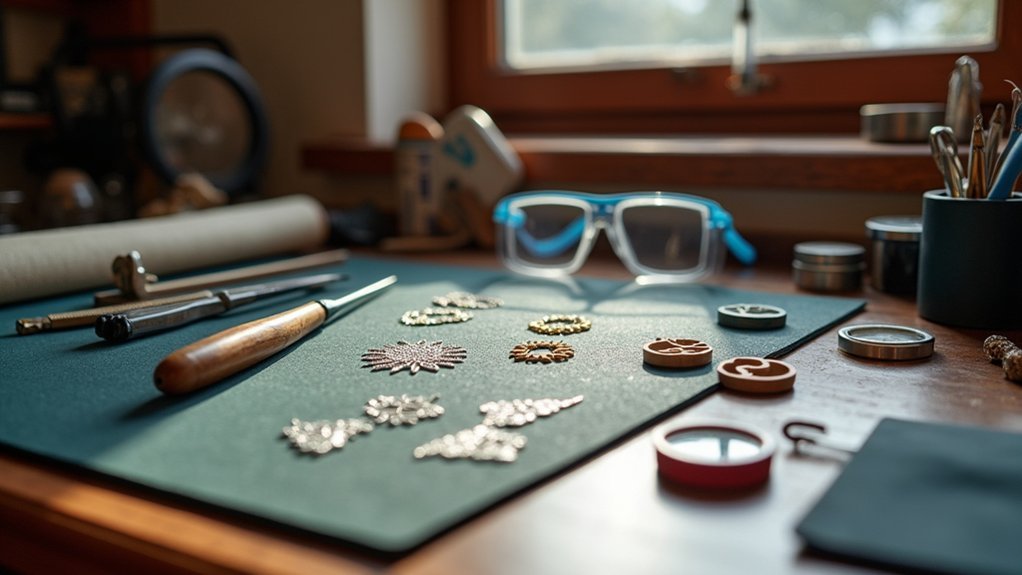
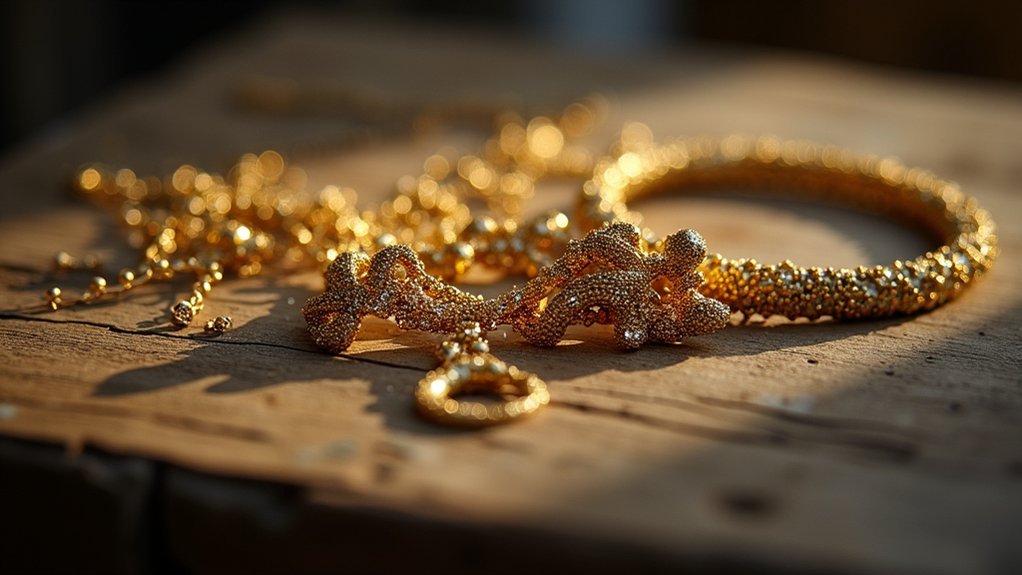
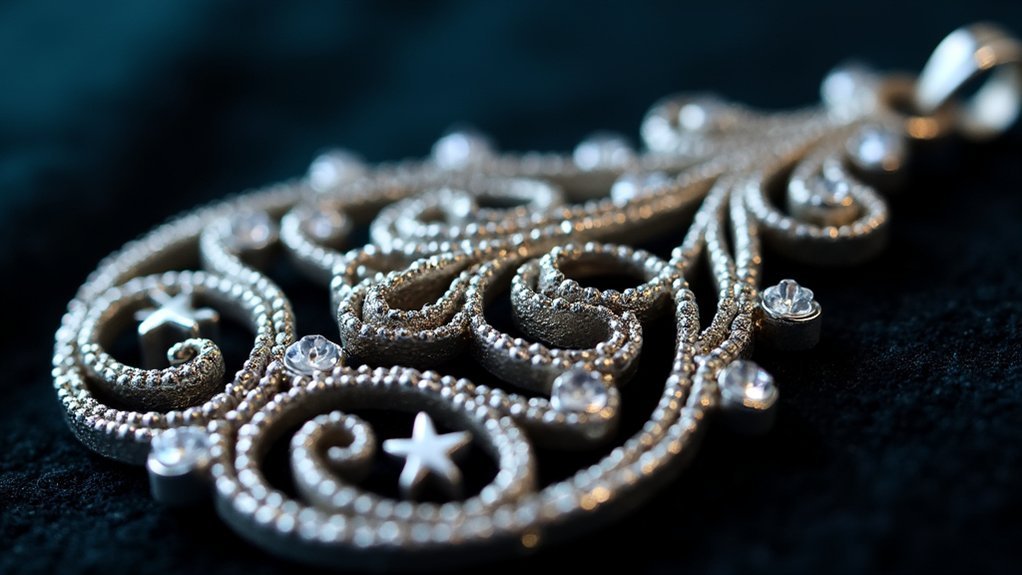
Leave a Reply